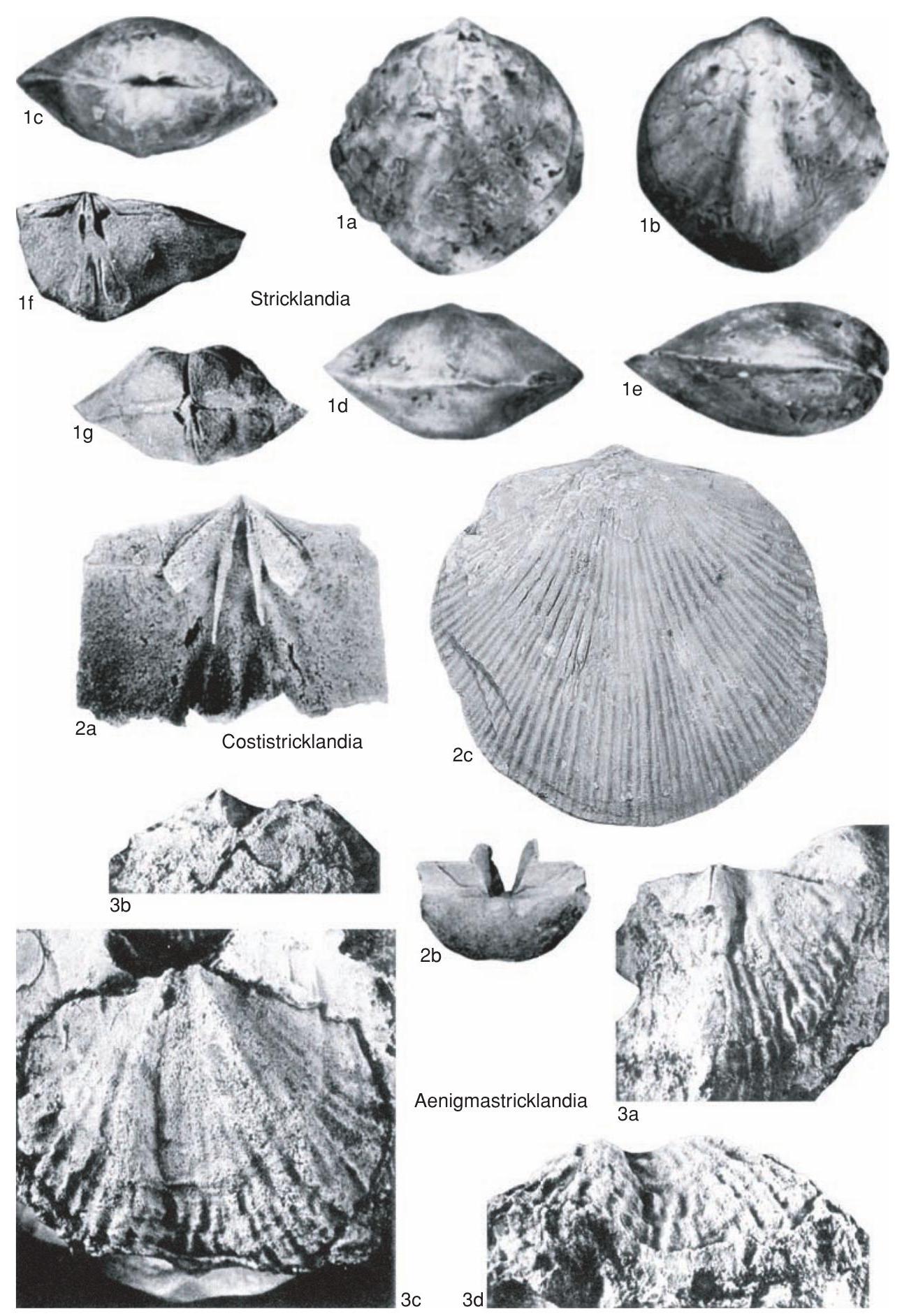Welcome to the Treatise on Invertebrate Paleontology!
Please enter a genera name to retrieve more information.

Stricklandia
Classification
Phylum:
Brachiopoda
Class:
Rhynchonellata
Order:
Pentamerida
Superfamily:
Stricklandioidea
Family:
Stricklandiidae
Subfamily:
Stricklandiinae
Formal Genus Name and Reference:
Stricklandia Billings, 1859a, p. 132, Stricklandinia BILLINGS, 1863a, p. 370, obj.
Type Species:
Atrypa lens J. Sowerby in Murchison, 1839, p. 637, SD OEHLERT, 1887a, p. 1310
Images
(Click to enlarge in a new window)
Stricklandia Billings, 1859a, p. 132 *Atrypa lens J. Sowerby in Murchison, 1839, p. 637, SD Oehlert, 1887a, p. 1310 =Stricklandinia Billings, 1863a, p. 370, obj.. Medium to large, smooth to anteriorly weakly plicate, subcircular to elongate, interareas relatively wide in older forms to narrower in younger forms, moderately ventribiconvex, rodlike crura, outer hinge plates enlarged in younger forms. lower Silurian: North America, Eurasia.--Fig. 674, $1 a-e$. * S. lens (Sowerby), 70.8 meters, Sulustvere borehole, Llandovery, Adavere Stage Gorizont, Estonia, ventral, dorsal, posterior, anterior, lateral views, x1.5$ (Rubel, 1970).-Fig. 674, 1f-g. S. lens progressa, $\\mathrm{C}_{1}$ beds, Sefin footbridge, Llandovery, Wales, mold of dorsal cardinalia, internal mold of posterior, x1$ (Williams, 1951).
Synonyms
Stricklandinia
Geographic Distribution
North America, Eurasia
Age Range
Beginning Stage in Treatise Usage:
lower Silurian
Beginning International Stage:
Rhuddanian
Fraction Up In Beginning Stage:
0
Beginning Date:
443.07
Ending Stage in Treatise Usage:
lower Silurian
Ending International Stage:
Homerian
Fraction Up In Ending Stage:
100
Ending Date:
426.74
Description
Medium to large, smooth to anteriorly weakly plicate, subcircular to elongate, interareas relatively wide in older forms to narrower in younger forms, moderately ventribiconvex, rodlike crura, outer hinge plates enlarged in younger forms
References
Museum or Author Information
Classification
Phylum:
Brachiopoda
Class:
Rhynchonellata
Order:
Pentamerida
Superfamily:
Stricklandioidea
Family:
Stricklandiidae
Subfamily:
Stricklandiinae
Formal Genus Name and Reference:
Stricklandia Billings, 1859a, p. 132, Stricklandinia BILLINGS, 1863a, p. 370, obj.
Type Species:
Atrypa lens J. Sowerby in Murchison, 1839, p. 637, SD OEHLERT, 1887a, p. 1310
Images
(Click to enlarge in a new window)
Stricklandia Billings, 1859a, p. 132 *Atrypa lens J. Sowerby in Murchison, 1839, p. 637, SD Oehlert, 1887a, p. 1310 =Stricklandinia Billings, 1863a, p. 370, obj.. Medium to large, smooth to anteriorly weakly plicate, subcircular to elongate, interareas relatively wide in older forms to narrower in younger forms, moderately ventribiconvex, rodlike crura, outer hinge plates enlarged in younger forms. lower Silurian: North America, Eurasia.--Fig. 674, $1 a-e$. * S. lens (Sowerby), 70.8 meters, Sulustvere borehole, Llandovery, Adavere Stage Gorizont, Estonia, ventral, dorsal, posterior, anterior, lateral views, x1.5$ (Rubel, 1970).-Fig. 674, 1f-g. S. lens progressa, $\\mathrm{C}_{1}$ beds, Sefin footbridge, Llandovery, Wales, mold of dorsal cardinalia, internal mold of posterior, x1$ (Williams, 1951).
Synonyms
Stricklandinia
Geographic Distribution
North America, Eurasia
Age Range
Beginning Stage in Treatise Usage:
lower Silurian
Beginning International Stage:
Rhuddanian
Fraction Up In Beginning Stage:
0
Beginning Date:
443.07
Ending Stage in Treatise Usage:
lower Silurian
Ending International Stage:
Homerian
Fraction Up In Ending Stage:
100
Ending Date:
426.74
Description
Medium to large, smooth to anteriorly weakly plicate, subcircular to elongate, interareas relatively wide in older forms to narrower in younger forms, moderately ventribiconvex, rodlike crura, outer hinge plates enlarged in younger forms
